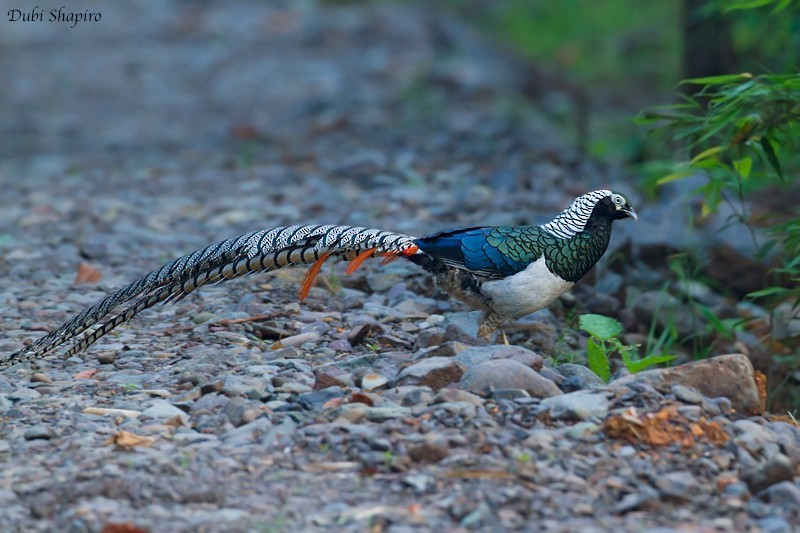Lady Amherst's Pheasant
A species of Ruffed Pheasants, Also known as Lady Amherst Pheasants Scientific name : Chrysolophus amherstiae Genus : Ruffed Pheasants
Lady Amherst's Pheasant, A species of Ruffed Pheasants
Also known as:
Lady Amherst Pheasants
Botanical name: Chrysolophus amherstiae
Genus: Ruffed Pheasants
Content
Description General Info
 Photo By Dubi Shapiro
Photo By Dubi Shapiro Description
The adult male is 100–120 cm (40-48 in.) in length, its tail accounting for 80 cm (31 in) of the total length. It is unmistakable with its nuchal cape white black, with a red crest. The long grey tail and rump is red, blue, dark green, white and yellow plumage. The "cape" can be raised in display. This species is closely related to the golden pheasant (C. pictus), but has a yellow eye, blue-green bare skin around it. The bill is horn-coloured and they had blue-gray legs. The female is much less showy, with a duller mottled brown plumage all over, similar to that of the female common pheasant (P. colchicus) but with finer barring. She is very like the female golden pheasant, but has a darker head and cleaner underparts than the hen of that species. Despite the male's showy appearance, these birds are very difficult to see in their natural habitat, which is dense, dark forests with thick undergrowth. Consequently, little is known of their behaviour in the wild. 
Size
66 - 173 cm
Life Expectancy
7-19.6 years
Nest Placement
Ground
Feeding Habits
Lady Amherst's Pheasant dines on a range of insects like earwigs, spiders, and small beetles, complementing its diet with plant materials such as fern fronds, bamboo sprouts, and fruits. It forages primarily on the ground, utilizing its natural habitat for food resources, and exhibits no unique dietary adaptations.
Habitat
Lady Amherst's Pheasant is typically found in woodland environments, especially those with hills and bamboo growths. Its preferred habitats include dense shrubbery and thicket areas, emphasizing foliage like Rhododendron scrub. Generally, lady Amherst's Pheasant occupies elevations between 1800 and 4600 meters, favoring higher altitudes compared to its close relatives. In regions outside its native range, it adapts to half-grown or mixed forestry plantations.
Dite type
Omnivorous
General Info
Feeding Habits
Bird food type
Behavior
They feed on the ground on grain, leaves and invertebrates, but roost in trees at night. Whilst they can fly, they prefer to run, but if startled they can suddenly burst upwards at great speed, with a distinctive wing sound. The male has a gruff call in the breeding season. 
Distribution Area
The species is native to southwestern China and far northern Myanmar, but has been introduced elsewhere. Previously, a self-supporting feral population was established in England, the stronghold of which was in West Bedfordshire. Lady Amherst first introduced the ornamental pheasant on her estates, near the Duke of Bedford's Woburn Abbey, where the birds were also shot for game and interbred. However, since late 2015, it has been believed to be eradicated in Great Britain, with no confirmed sightings since March 2015. 

 Photo By Dubi Shapiro
Photo By Dubi Shapiro Scientific Classification
Phylum
Chordates Class
Birds Family
Phasianidae Genus
Ruffed Pheasants Species
Lady Amherst's Pheasant